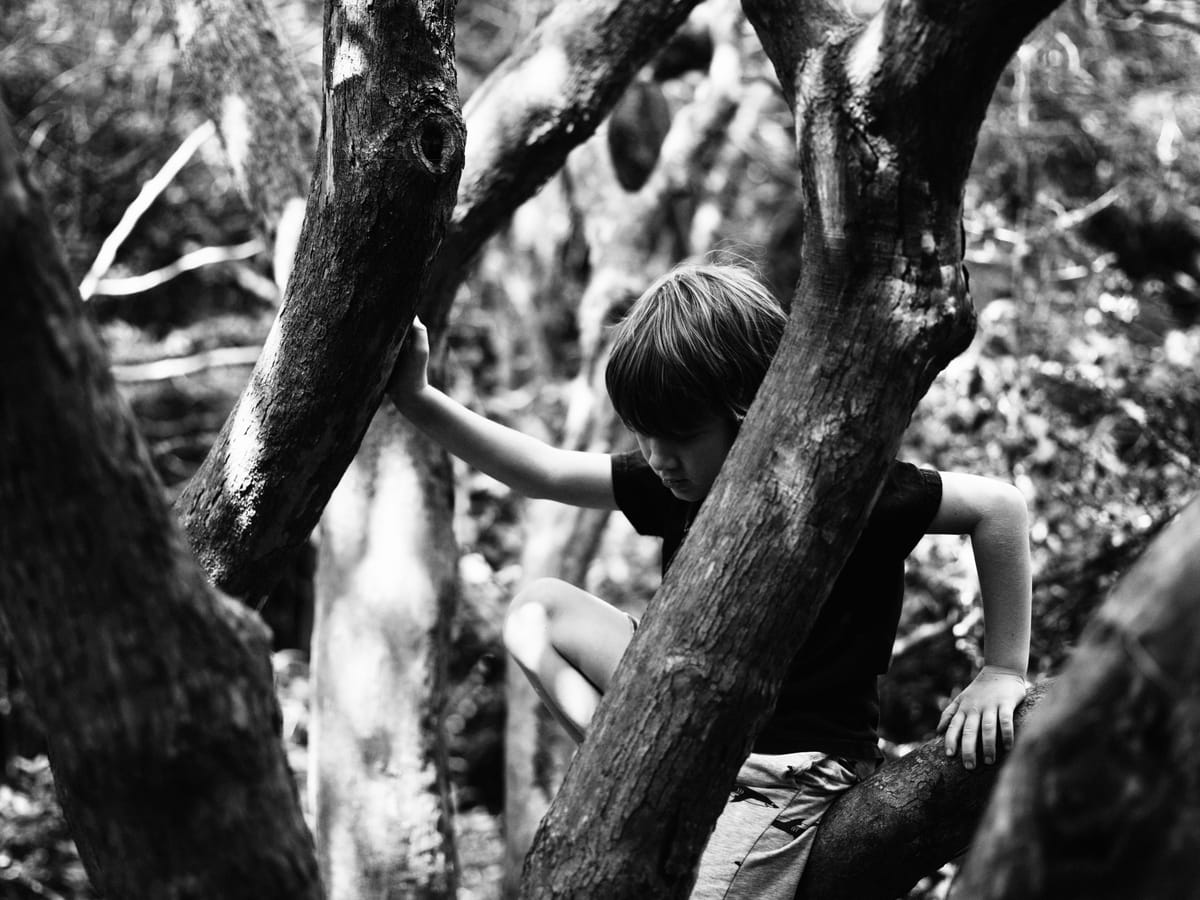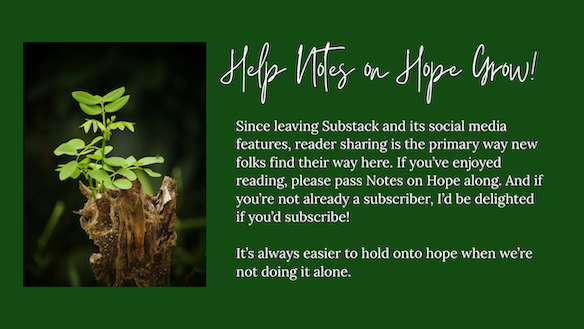The Children Expect Us in the Future
Committing to possibility when we feel the tug of fear or cynicism

“If you name it hope instead of impossible.
If you hold it with tenderness.
If you call it the blessing of your ancestors.
If you look around and see the faces
of everyone you love
trying to save the world with you.
Then this work becomes love.
And even mountains will move.”
~Nikita Gill
There is almost always a phase, at some point during the school year in preschool classrooms, when children become consumed with scale. They work, day after day, to construct block towers that rise ever taller, collapse, and are rebuilt to greater heights. They stretch long lines of connecting cubes across the classroom floor, linking one to the next methodically and crawling under furniture to pass their candy-colored roadways between the legs of tables and chairs and under easels. They make endless chains of links, paperclips, or paper strips, and they stand on chairs to build spires out of magnetic tiles that double their own height.
There’s often an exuberant thrill in the testing of classroom rules and authority, as children stand on and crawl beneath furniture to accomplish these feats—activities that make adults nervous and quick to curtail their risks. But I always found that the dominant emotional buzz that filled the classroom, as the children created and recreated these ambitious structures, no matter how many times they fell, was one of a near obsessive commitment to possibility. There was an all-consuming drive to reach past the limits of what prior experience might deem realistic. Each time a new tower stretched higher than the previous one before collapsing, the children were eager to build again and to push past that new limit as well. I think this is, perhaps, the most central drive of childhood, because without an innate conviction that more is possible than whatever the present may indicate, their learning would stagnate—they would be content with walking and never run or jump or swing across the monkey bars, and they would be satisfied with the ability to communicate their most basic needs, rather than compelled to express ever more complex questions and ideas.
Children focus these drives differently depending on their individual passions and interests, particularly once they’ve mastered the most fundamental capacities of independence. Some are more pulled toward physical tasks, running faster and climbing higher. Some build. And some spend reams of paper perfecting the arch of a rainbow or the contours of a horse. But, regardless of the task, there is a feeling of being consumed with possibility—an inability to leave well enough alone. It is the deep, internal compulsion that fuels their development.
It would be easy, in our competition-driven adult universe, to view competitiveness as the primary motivator for their ambitions. But, in my many years in the classroom and throughout the developmental literature, collaboration appears as a lubricant for possibility far more often than individual one-upmanship does. This drive to extend limits is usually more rooted in proving that a vision can be accomplished than in proving that any particular individual has a unique capacity to realize that vision. The delight is found in observing a new reality emerging with each creation, and that delight is often communal and contagious, as more and more children will gather to admire and contribute to a feat in process. Even the collapse can be exhilarating, as it creates the conditions for setting the next horizon, usually with more children recruited in each attempt. Both victory and defeat are thrilling, because both give the child a new view forward rather than back. Of course, disagreements break out and there are sometimes tears of frustration, but ultimately the fervor of imagining what’s next almost always overcomes the dismay of the present. Past destruction informs new creation; it does not encumber creativity with cynicism.
If there is a great gift of childhood, I think it is this ability to unearth lessons in the difficult past and present, while still retaining an almost insatiable commitment to possibility.
Loris Malaguzzi, the educator and psychologist who founded the Reggio Emilia approach to education, described this outlook as one of “nostalgia for the future,” and it is the disposition of childhood that he was most determined for adults to relearn and embody in their own approach, not only to education, but also to the work of understanding history, while keeping their gaze fixed ahead and rooted in hope—in what could be, rather than in the replication of what was or is.
This outlook had its origin in a bicycle ride through the rubble of WWII to a nearby town where Malaguzzi had heard rumors that the local farmers and factory workers were, only days after the Liberation, attempting to build a school from the remains of crumbled buildings. In an interview, republished in The Hundred Languages of Children, he recalled his reaction to visiting this town and seeing the work they were beginning.
“I realized that the impossible was a category to be redefined [...] the intuition and the realization of the project were all born there, in Cella, in the midst of farmers and factory workers. I sensed that it was a formidable lesson of humanity and culture, which would generate other extraordinary events. All we needed to do was to follow the same path. [...] And it remained an uninterrupted lesson given by men and women whose ideas were still intact, who had understood long before I had that history can be changed, and is changed by taking possession of it, starting with the destiny of the children.”

So much of our current reality is consumed by a profound and often suffocating nostalgia, as powerful figures aim to take us back to a version of the past they idealize. Nostalgia is traditionally defined as looking backwards. It is a wistful longing for a recollection of the past that is recast with a rose hued gaze, regardless of whether the version of the past we hold onto is an honest reflection of history. Wistful as it may be, this longing to travel back in time is not delicate. Nostalgia has become so powerful that it threatens to reclaim all the achievements of freedom won and yet to be won as its sacrifice. In clinging to the past, we risk erasing the brightest possibilities of the future.
Malaguzzi, and the children building their teetering block towers in every preschool classroom, offer an alternate definition for nostalgia, and it is their nostalgia that I think we must cling to today instead.
Malaguzzi proposed—out of the revelation of observing ordinary people finding hope for the future amidst the ashes of destruction, and out of his many years observing and listening to children—that we formulate a new kind of nostalgia, one that looks to the future instead of the past. His definition of nostalgia takes this same sensation of deep longing but relocates its focal point away from the deceptive glow of recollection and toward imagining a new future that is shaped by insisting on possibility instead of memory—on building something that’s never been built before, rather than reconstructing false and dusty reminiscence. He explained, in his concluding thoughts at the end of the same interview quoted above,
“In this world, deception continues, at times cynical and violent, at times more subtle and sophisticated, laced with hypocrisy and illiberal theories. [...] The continuing motivation for our work has in fact been an attempt to oppose, albeit with modest means, this deception and to liberate hopes for a new human culture of childhood. It is a motive that finds its origin in a powerful nostalgia for the future and for mankind.”
Children live into possibility. It is their developmental job to constantly push the horizon and move toward the future. While they certainly have moments, as they grow, of looking back and wishing for the security that accompanied less independence, they can’t help but continue to grow, learn, and imagine as development propels them ever forward. They may, at times, wish to be babies again and enact these longings in their play, but they also know, even in their deepest wells of magical thinking, that backwards motion isn’t possible or truly desirable as an outcome beyond fantasy.
The fact that children have no choice but to live into the future is the primary reason Malaguzzi saw it as a moral obligation for adults to do the same, because he viewed the form of nostalgia that leads us to build alters to the past as an abandonment of children, who do not have the luxury of living backwards. In a speech accepting the Kohl International Education Award in 1993, Malaguzzi said, “we should think that we have more need of being nostalgic, not so much about the past, but more nostalgic about the future. The children expect us in the future.”
A teacher I worked with once told me that, when she visited the schools in Reggio Emilia, the educators there explained that they defined Malaguzzi’s notion of “nostalgia for the future” simply as love—that in loving children and in loving the world, we commit to hope and to looking ahead, knowing that that’s where they must go. Stepping back in time leaves children alone in the journey they are compelled to make, so to love them is to let go of whatever pulls us back, and instead to be pulled forward with them, hand in hand.
As children are acutely aware, living toward the future doesn’t free us of the present. This stance isn’t about holding out for rainbows as we hunker down in the midst of a storm. Living toward the future and toward possibility isn’t passive. It requires acknowledgment of and interaction with all that is challenging about the present. It requires a willingness to pick up the blocks each time they fall and begin again. It requires ingenuity and flexibility to press ahead with limited or less than ideal resources, as the materials available are not infinite and are usually imperfect. (As any preschool teacher can tell you, there are never enough squares.) And it requires risk. This is the part adults are usually the least comfortable holding, with children or in our own grown-up worlds. Our breath tightens as we watch them stand on their tiptoes on a chair, stretching for the top of a tower, just as it tightens when we pull back from the ideas and leaders who seem too bold, audacious, or ahead of the status quo for our comfort. Imagining a better future requires resilience, flexibility, and risk in the present. It requires a vision that is bigger than what we’ve known. These are the materials of hope. The only way forward is through, as the saying goes. Committing to the future is never static or regressive, but it does demand that we act in the present. Children know this, as did Malaguzzi when he implored that we orient our longing toward possibility.
We are living through a time of significant collapse and regression—a time of aggressive nostalgia for the very periods in history that we’ve struggled most fiercely to free ourselves from. Too often children are used as the excuse for this regression, as though the past were kinder to them and ought to be recreated for their protection, even though one need only look to the history of child mortality, labor, education, or segregation to know that the past was not better for children.
Instead, children hold the only antidote to the dangers of moving swiftly backward, both in their own approach to the world and in our obligation to their future. The antidote is to learn from history while orienting our longing away from the past and toward the future, as children do each day, testing the limits of rationality and caution in their play. Taking this approach requires vision and bravery. But, as Malaguzzi reminded us, “the children expect us in the future,” so that is the direction we will need to focus our gaze, even if it necessitates that we release our own fears and hesitations, just as good teachers do when they allow children to stretch beyond their reach.
Wishing you the courage and vision to move the horizon,
Alicia
A few things I found helpful and hopeful this week…
- An essay about school lunch debt and the ways we manage working for systemic change, while mitigating immediate harm
- An interview on freedom and the future with Leonard Peltier
- Messages of hope to LGBTQ+ youth from children's book authors
- Why Movements Need to Learn to Fly Like Bees and Thread Like Spiders
- How to Give and Receive Help in Texas






